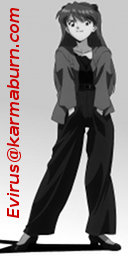|
|
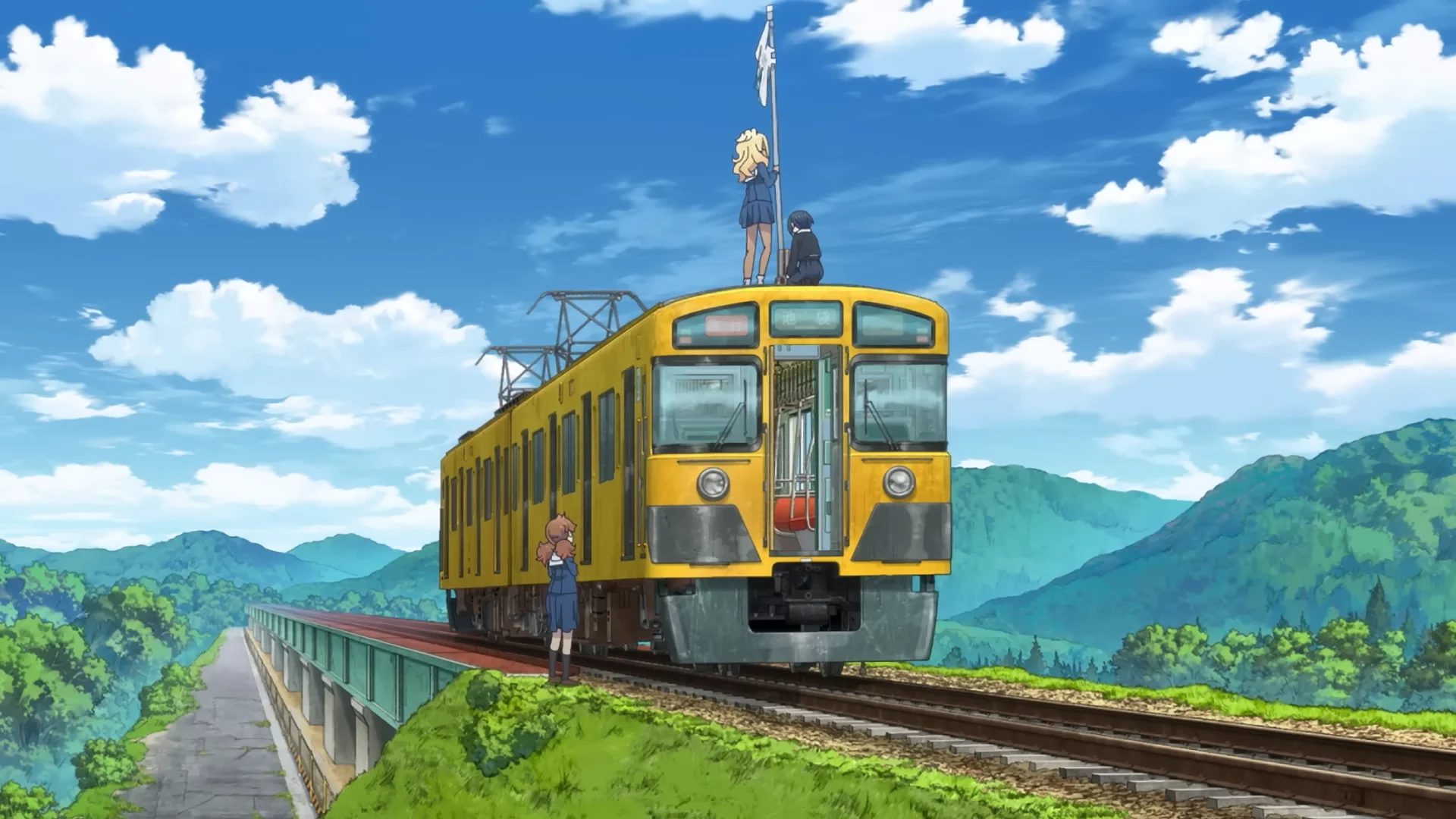
Where we're going, we don't need roads.
Last week, I provided a quick rundown of what I expect to watch this season. This post augments that one by including additional titles that I plan to try, but won't necessarily watch all the way through. By the time I finally post this, the first episode of Shuumatsu Train Doko e Iku (Where Does the Doomsday Train Go? or Train to the End of the World) should be out. This is an original anime with Mizushima Tsutomu attached, so I'm more optimistic about it than the rest of the shows I'm considering. In many of those cases, I've only read potentially misleading descriptions and won't even have necessarily watched the corresponding trailers.
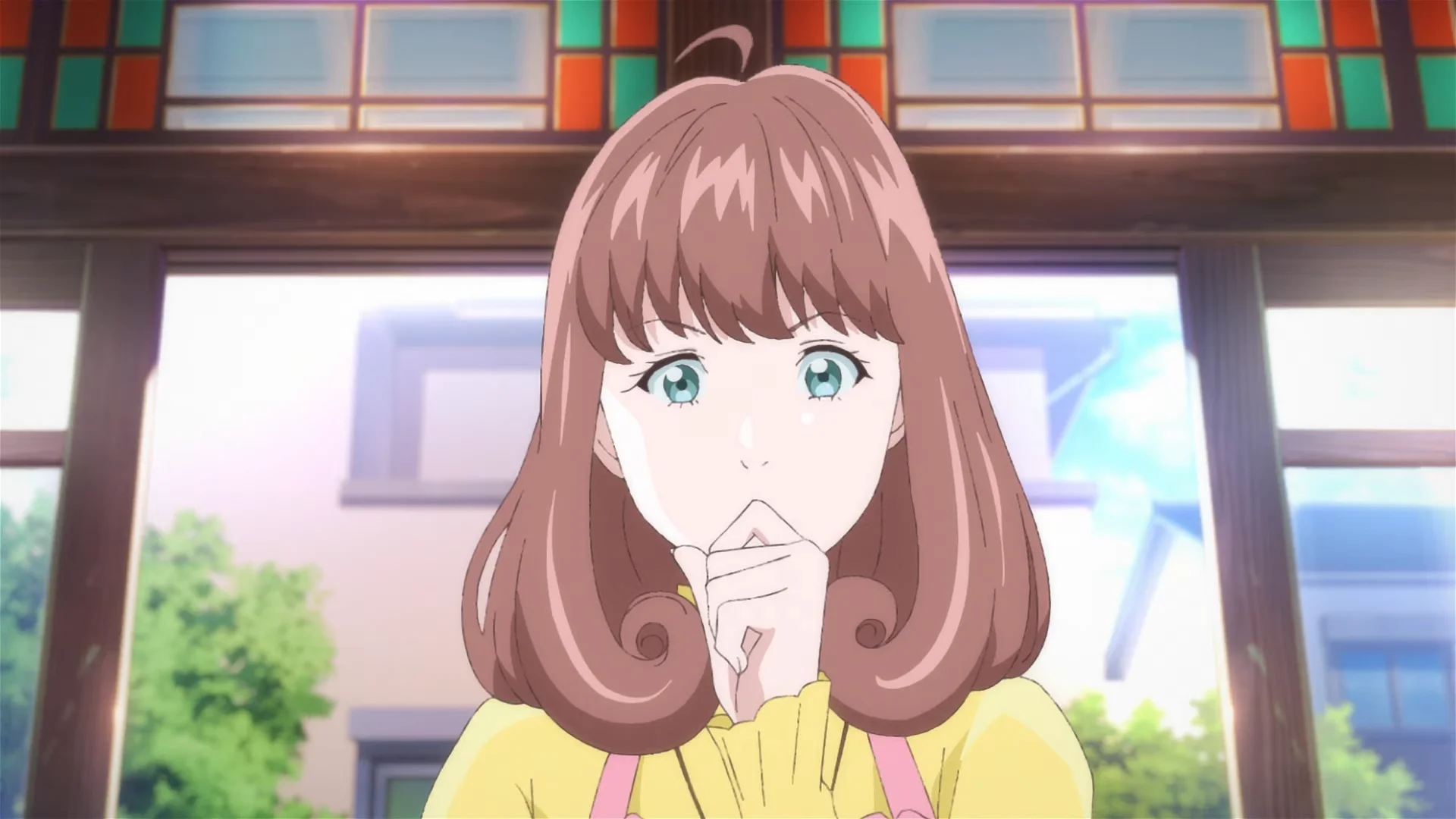
I don't know anything about you.
Astro Note is one of those anime I know nothing about. I believe the first episode has already leaked, but I remain wholly ignorant about its contents aside from learning it's an original anime. It's enough to warrant a try out of general principle.
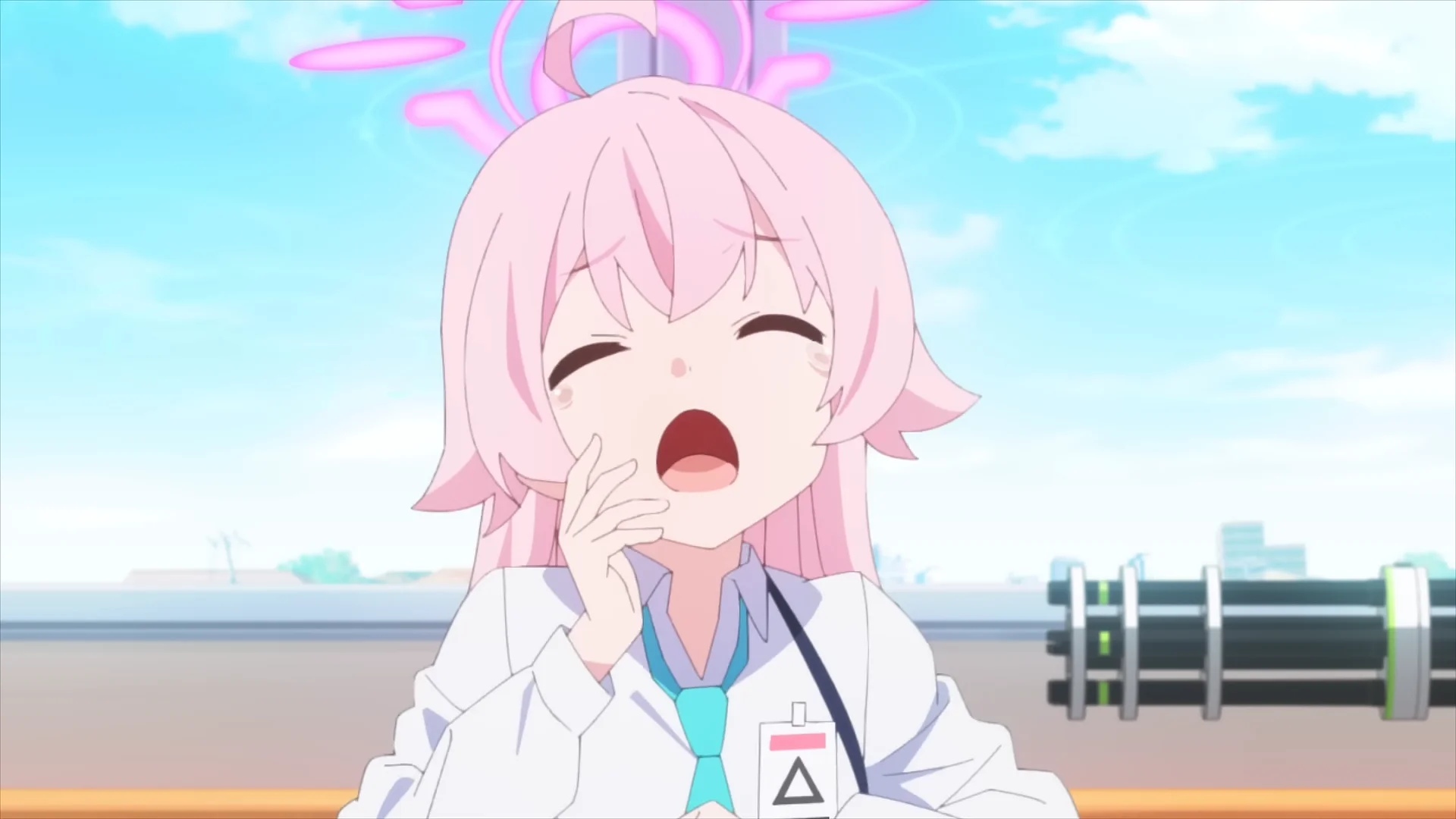
Have I even seen any fan art of you? You don't look familiar at all.
Blue Archive I know only from fan art. Based on that, I'm confident the series will be about scantily clad schoolgirls making passes at their teacher while toting around firearms designed by people who know absolutely fuck all about guns. I did watch a trailer, and it mostly seems to feature only the shrimpy kids. Where are all the aerodynamic students?! Are the shrimpy girls the ones who are popular among those who actually play the game? Did fan art lead me astray?
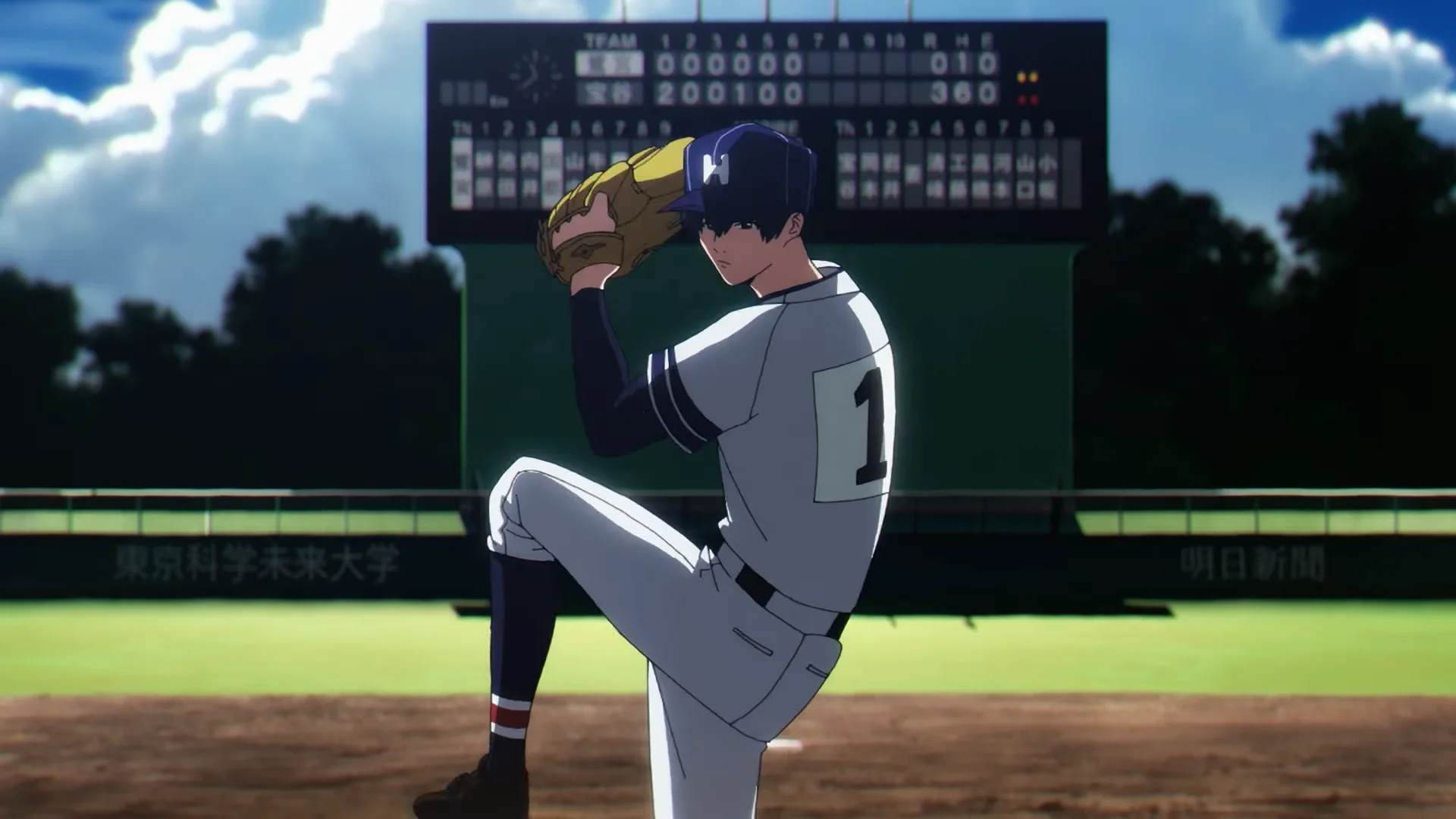
I assume this has nothing to do with Boukyaku no Senritsu.
Boukyaku Battery (Oblivion Battery) is a baseball anime with an amnesia gimmick. Curiously, it's the catcher who lost his memory, and not the pitcher. I could totally see how this story would work with a now-clueless pitcher taking cues from a knowledgeable catcher (you know, like in Bull Durham), but having a catcher who doesn't know what he's doing sounds like a bad time for a battery. I also noticed there's an ONA from 2020 with these characters except set after high school, while this new TV series is set at the beginning of high school. I'm not sure what the deal is, but I'm going to assume the ONA adapted material from later in the original manga, and it's not the TV series aging everyone down to make them more relatable to an adolescent audience.
As for the rest of the new Spring 2024 anime that I'm going to try out...
- Jii-san Baa-san Wakagaeru (Grandpa and Grandma Turn Young Again). Everything I know about this comes from its title. I can't tell from the promo art if I'm looking at the couple while they're old, but they look oddly young, or if I'm seeing them when they're already young again, but they still look oddly old.
- Unnamed Memory. @frog_kun raved about the source material years ago. My taste and hers often don't align, and she tends to be a lot more enthusiastic than I am about the same titles, but it's still enough of an endorsement to warrant a try.
- Seiyū Radio no Ura Omote (The Two Sides of Voice Actor Radio). Hasegawa Ikumi is in it. I don't think she's voicing one of the leads, though.
- Ooi! Tonbo is about golf. Eh. Golf.
- NIJIYON ANIMATION 2. Yeah, I'm watching more because they're making more. It's a vicious cycle.
Posted in Astro Note, Blue Archive, Boukyaku Battery, Jii-san Baa-san Wakagaeru, Nijiyon Animation, Ooi! Tonbo, Seiyū Radio no Ura Omote, Shuumatsu Train Doko e Iku, Unnamed Memory | Tags: baseball, Bend Her Over a Kotatsu, General Principle, Hair, Idols, Light Novels, Mamikore, Season Introduction, Spring 2024, Twitter | Permanent Link

It's not a metaphor.
With less than a week left before the start of the Spring 2024 anime season, I currently have 19 shows that I'm willing to at least try. Moreover, I compiled this list weeks ago without closely scrutinizing what series will even be airing in April. There's a good chance I've overlooked multiple anime I'd also consider, and I may have missed series that were announced only recently. Based on past experiences, what's likely to happen is I'll end up dropping a lot of these, but that still leaves a significant number of shows to follow.
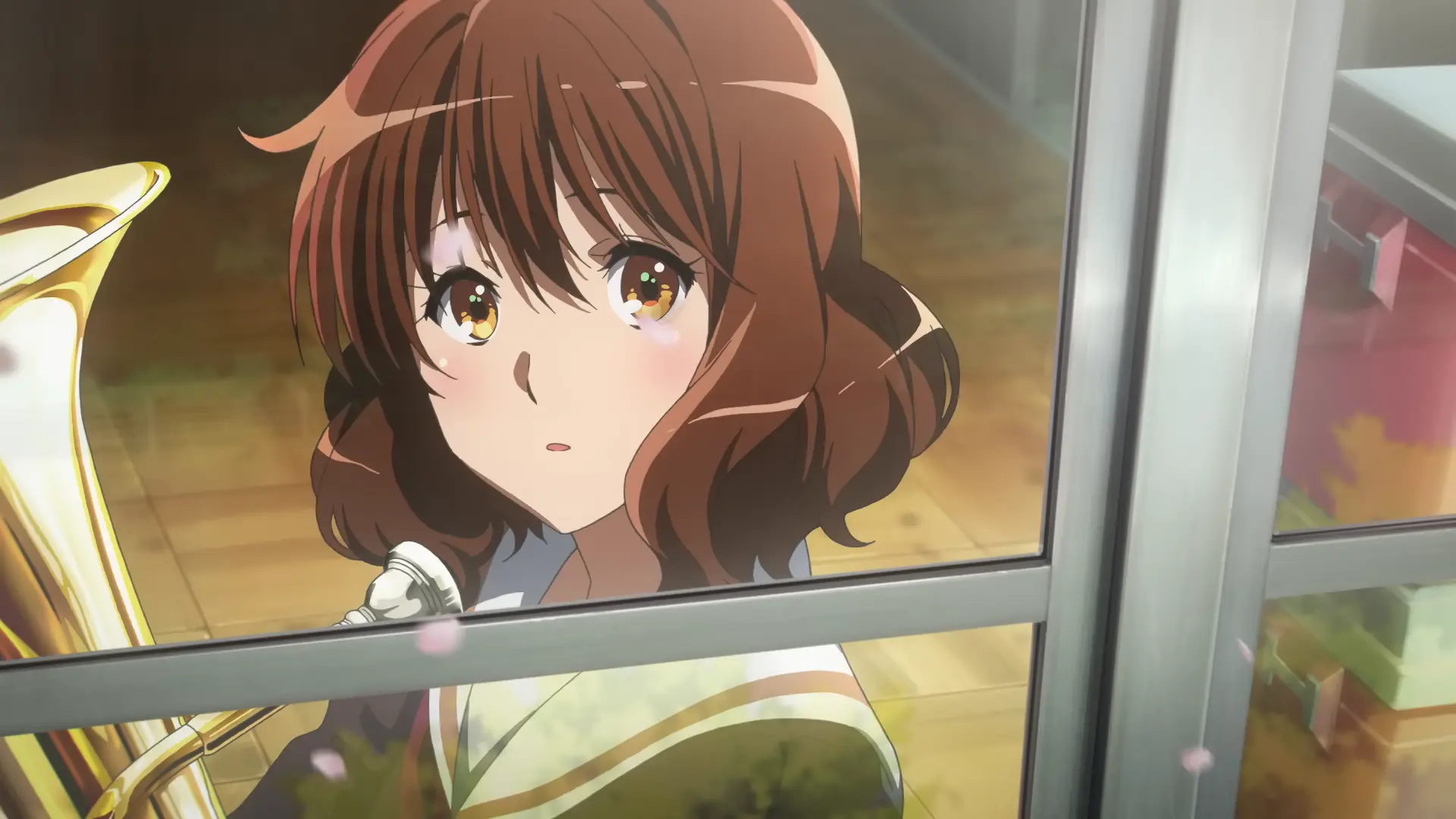
I didn't expect to like Hibike! Euphonium more now than when I started the series.
Some of these titles are a lock. For example, I'm guaranteed to follow Yuru Camp△ SEASON 3, Hibike! Euphonium 3, and Kono Subarashii Sekai ni Shukufuku wo! 3 (KONOSUBA -God's Blessing on This Wonderful World! 3), and Wonderful Precure! regardless of how they turn out. Likewise, I'll probably stick with Kimetsu no Yaiba: Hashira Geiko-hen (Demon Slayer: Kimetsu no Yaiba Hashira Training Arc) and The iDOLM@STER: Shiny Colors.

Everything know about Shiny idols, I learned from fan art.
Maou Gakuin no Futekigousha: Shijou Saikyou no Maou no Shiso, Tensei shite Shison-tachi no Gakkou e Kayou II Part 2 (The Misfit of Demon King Academy: History’s Strongest Demon King Reincarnates and Goes to School with His Descendants Season 2 Part 2) probably has enough momentum that I won't drop it outright, and I'm curious enough about the Spice and Wolf do-over (Ookami to Koushinryou: merchant meets the wise wolf) that I'll at least watch some of it, despite finding the first anime horribly overrated. Anyway, I support the assertion that good media do not need to be remade. Rather, it's the bad ones that would benefit from an opportunity at being unfucked. Since I have a generally negative opinion about the 2008 Spicy Wolf, then this remake should be right up my alley. I hope it's not bad a second time.
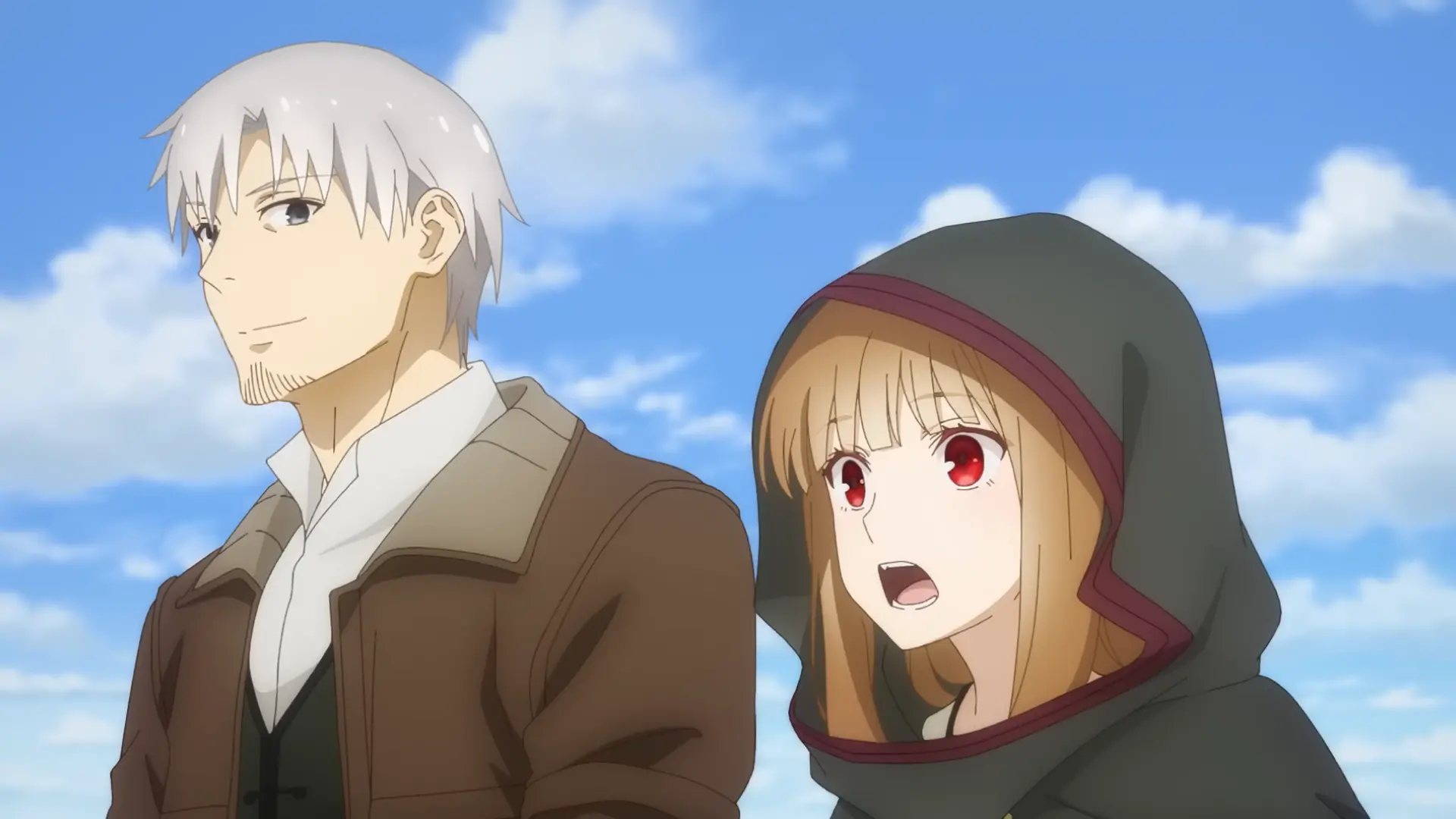
I've since learned Holo has "the form of a sweet 15-year-old girl" via @Kotobukiya_EN.
Besides these and a few more I didn't mention, the current lineup also includes eight new shows, at least two of which are anime-originals. There's even a baseball anime. This place could use more robots, though. Preferably giant ones, but I'm not going to be picky if the alternative is a robot-free-zone spanning three months, alas. It's probably hypocritical of me to say this, though, seeing as how I never got around to watching Brave Bang Bravern! during Winter 2024. I heard it's great. I suppose I could just watch that, but I can't resist New Season allure, and there's so much of it.
Note 1: I got to Spice and Wolf late, after its positive reputation was well established and generally uncontroversial. Well, I disliked nearly all of it for reasons too lengthy to include in this aside. I probably should have written a blog post detailing those reasons at some point instead of bitching about it on the IRC and on the Twitter (such as here, for example).
Posted in Hibike! Euphonium, Hibike! Euphonium 3, iDOLM@STER, THE, Kimetsu no Yaiba, Kono Subarashii Sekai ni Shukufuku wo!, Ookami to Koushinryou, Shiny Colors, Spice and Wolf, Yuru Camp△, Yuru Camp△ SEASON 3 | Tags: footnotes, Idols, Kayano Ai, Koshimizu Ami, Kyoto Animation, Light Novels, Magic School, May-December Romances, Remakes, Season Introduction, Sequels, Spring 2024, Twitter | Permanent Link
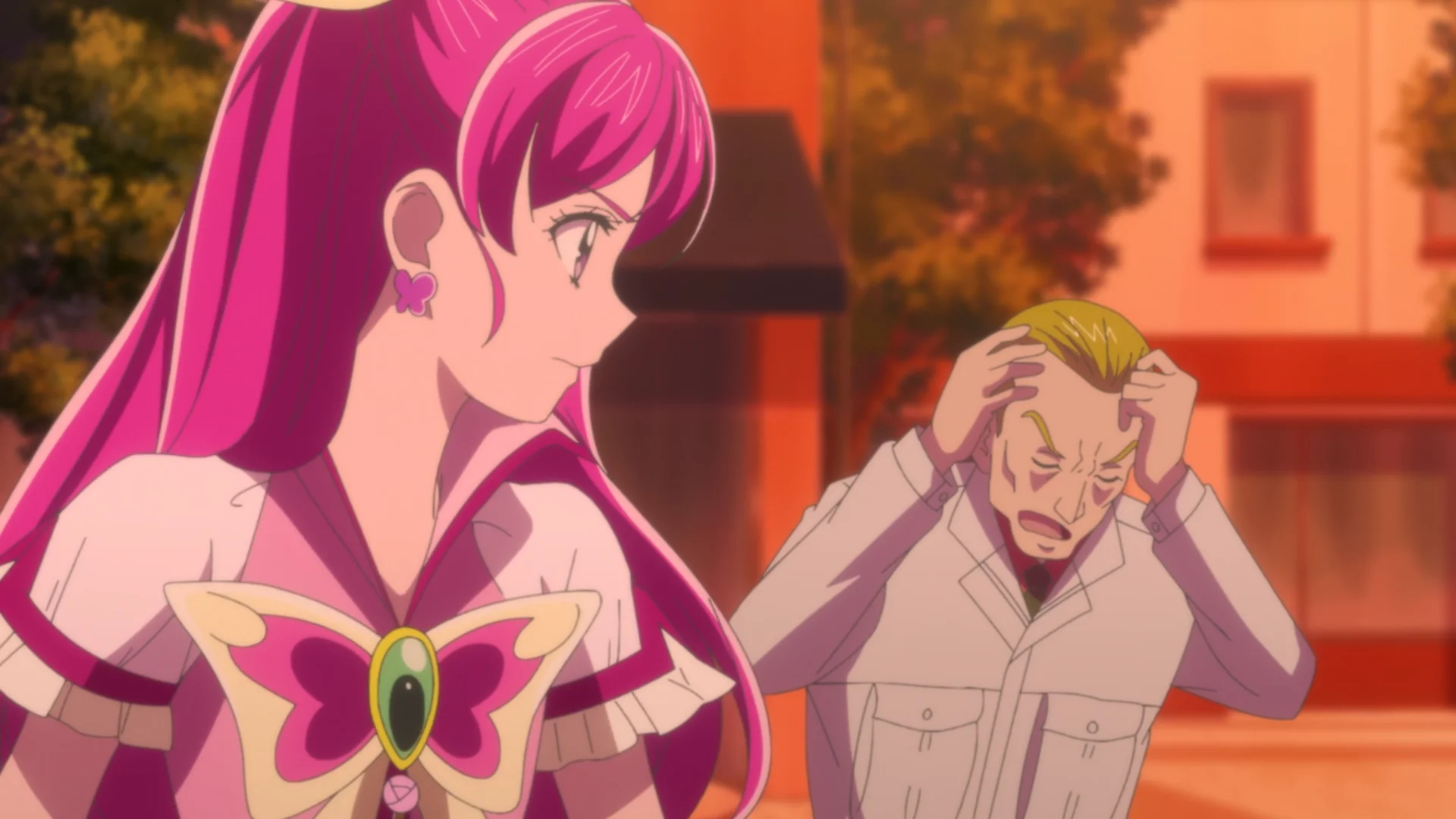
Believe it, Bunbee.
Should Kibou no Chikara ~Otona Precure '23~ (Power of Hope ~Precure Full Bloom~) be examined through the lens used for every other iteration in the Pretty Cure franchise, or should it be viewed (and judged) by standards applied to shows intended for adults? The expectations and allowances adopted can either magnify or diminish both the flaws (3DCG monsters, I'm looking in your direction) and the attributes of the series. I won't attempt to comprehensively address them all, but I bring this up now to acknowledge I'll be leaving some things unsaid. My attitude towards Otona Pretty Cure is generally positive, but you might catch a few laments if you follow me on the 𝕏 née Twitter.
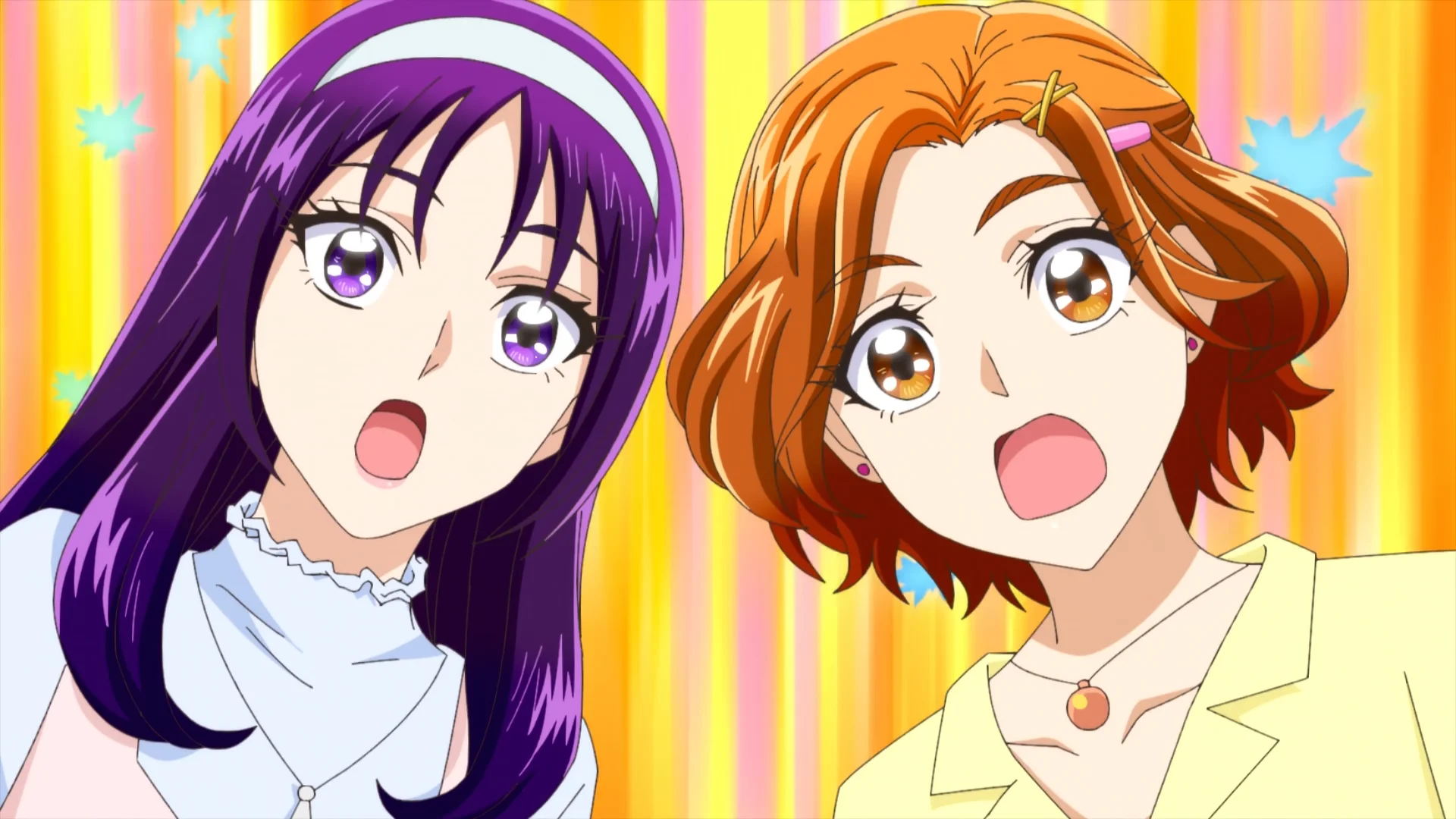
I'm shocked Saki ended up being the one with the best hair.
It still feels miraculous that Otona Precure exists at all. I also sort of got the sense that the production team shared this sentiment. Specifically, it seemed like I was watching a show being made by people who thought they only had one shot at this. That's not an unreasonable position to take. First Pretty Cure itself surely wasn't expected to launch a franchise that has run 20 years and counting. Maybe there will be more Otona Precure someday (the ending certainly leaves the possibility open), but it wouldn't be safe to assume there will be. Consequently, I got the impression there was pressure to cram as much as they could into the 12 episodes they had. (Yes, I'm aware there's some sort of Mahou Tsukai Precure! 2 thing planned, but I'm not expecting it to overlap with this.) Incidentally, there are spoilers the rest of the way out, so avert your eyes if you ain't watched this yet.
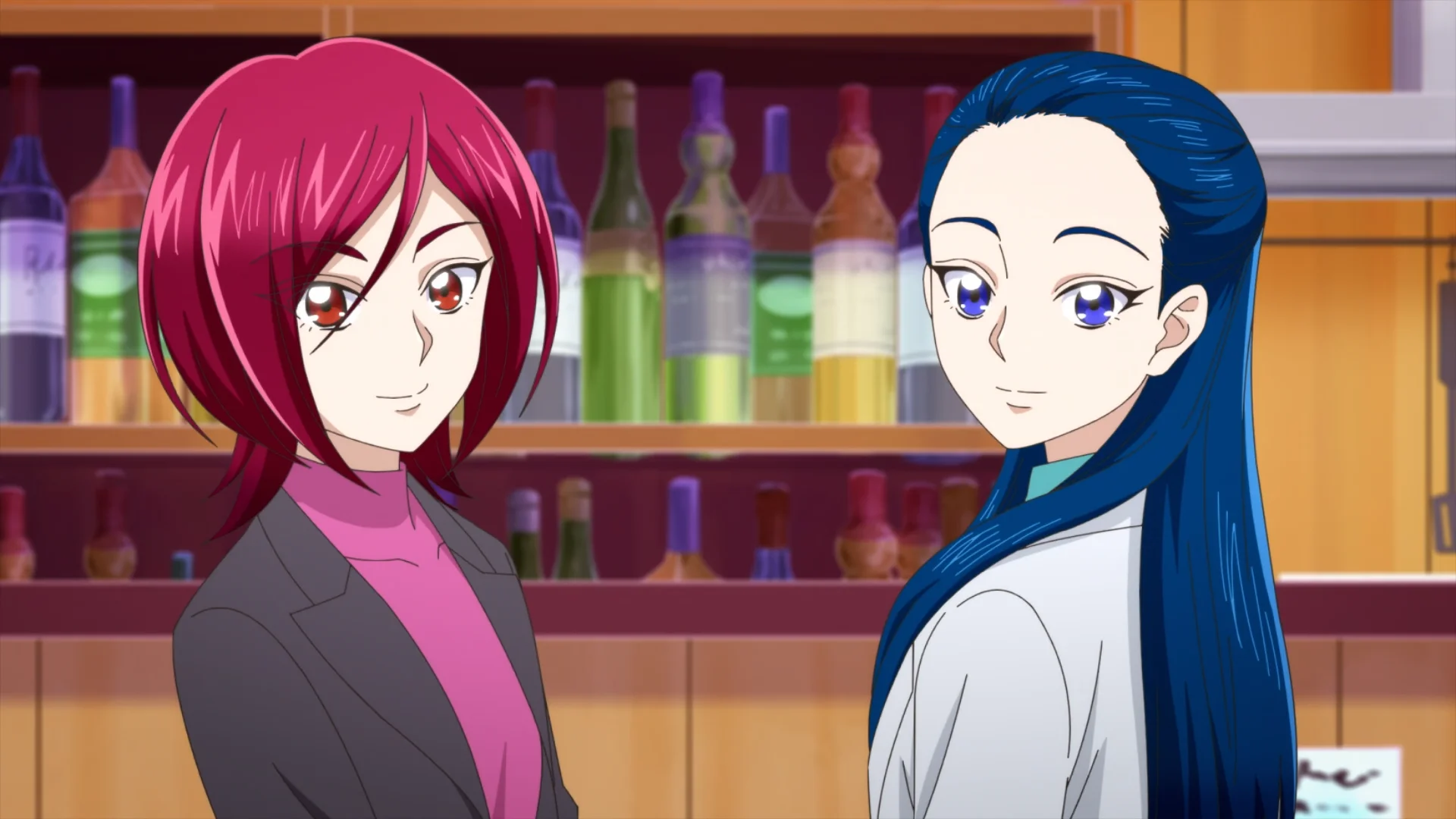
I wonder if all their paperwork is forged. I think they're technically illegal aliens.
Anyway, what I'm getting at is Otona Pretty Cure jammed a lot of stuff in here. Notably, Michiru and Kaoru finally got some recognition. As someone who has been constantly complaining about their omissions from team-up events and retrospectives, it was fantastic to see them return. Still, I'm on the fence about they way they were presented. Namely, I think they should still have at least some of the power they had in Splash Star. We did see them fly in the final episode, right? Possibly, they do have their powers, but chose to sit things out for the same reason Bunbee (who apparently does still have his powers) kept his head down and fled when pressed. But, yeah, this was a missed opportunity to officially confer upon them the Cure Bright and Cure Windy designations that they've long deserved.
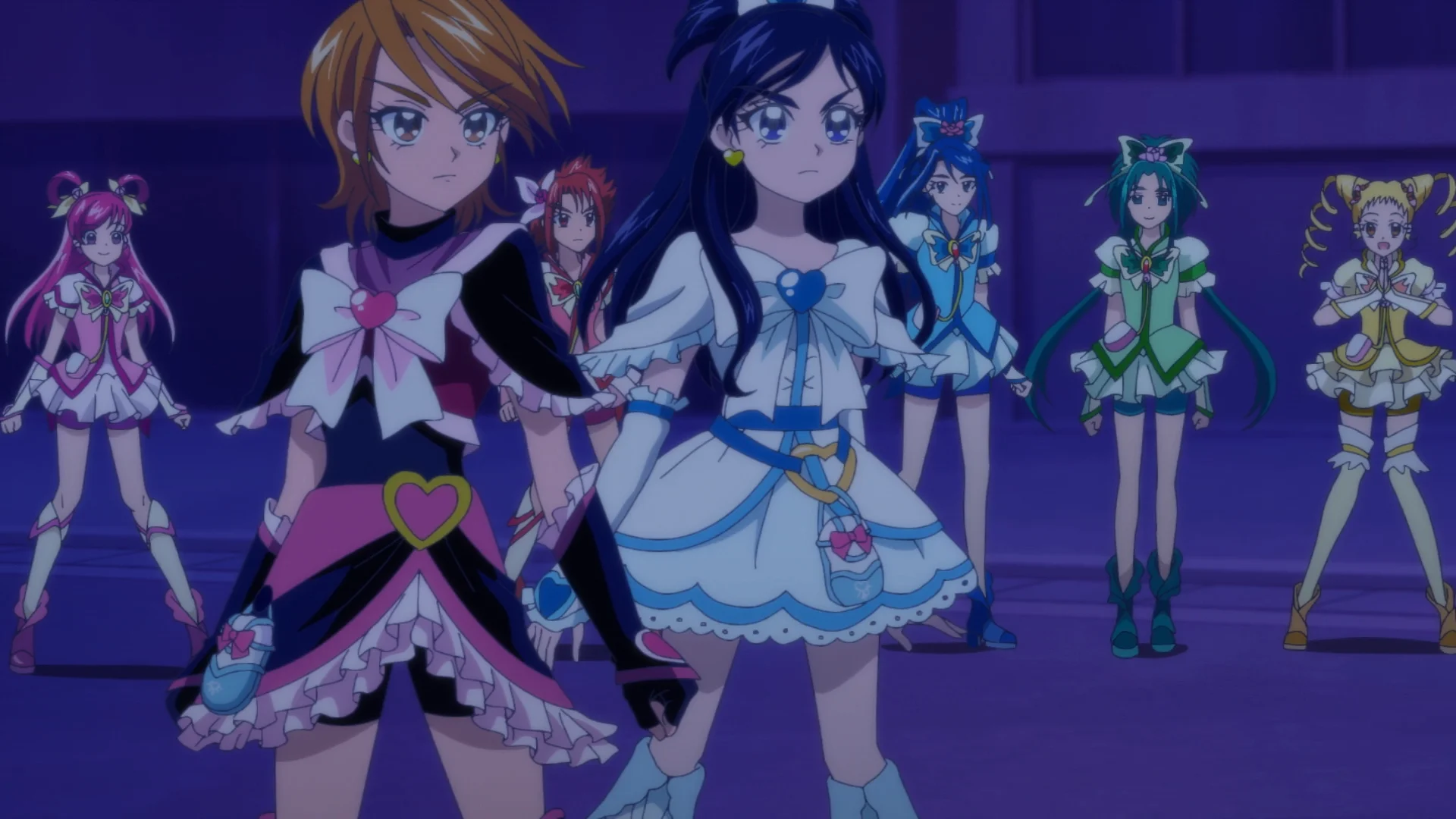
The opportunity to bring back the original battle costumes was right there!
So, no, Cure Bright and Cure Windy did not appear in any form, but Cure Black, Cure White, and Shiny Luminous all did. This was hidden from the promotional materials and made their appearance a bit of a surprise, but much less so considering it was telegraphed the instant Honoka's grandmother appeared in Otona Precure. As glad as I was to see them again, I would have preferred keeping them out of this season entirely, instead focusing on them in a future installment. Admittedly, that's difficult to do when there's no guarantee there will ever be any more later.
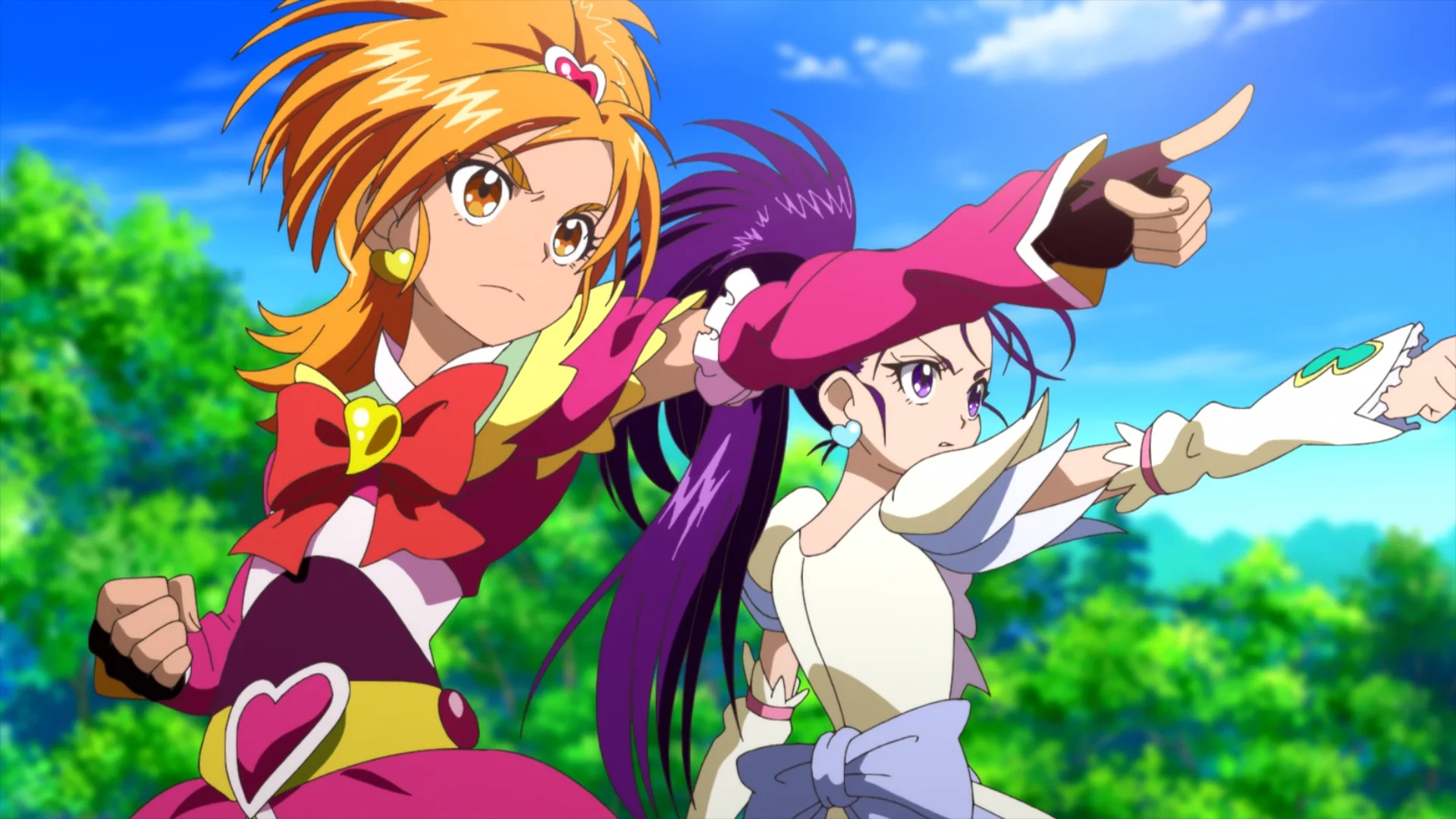
These two are so good.
I feel the need to point out the Max Heart and Splash Star teams were originally unable to unilaterally transform. They needed to be with their partners and their fairy counterparts. This would have been another reason to withhold first-generation Pretty Cure from Power of Hope ~Precure Full Bloom~. I would also have been okay with this limitation preventing Cure Bloom and Cure Egret from participating in the battles. Don't get me wrong, I love that Splash Star was included in this project, but Saki and Mai meant more to me than Bloom and Egret here. I think they could have still meaningfully contributed as regular adults who couldn't transform into Pretty Cure again, in contrast to the Yes! Cures who could.
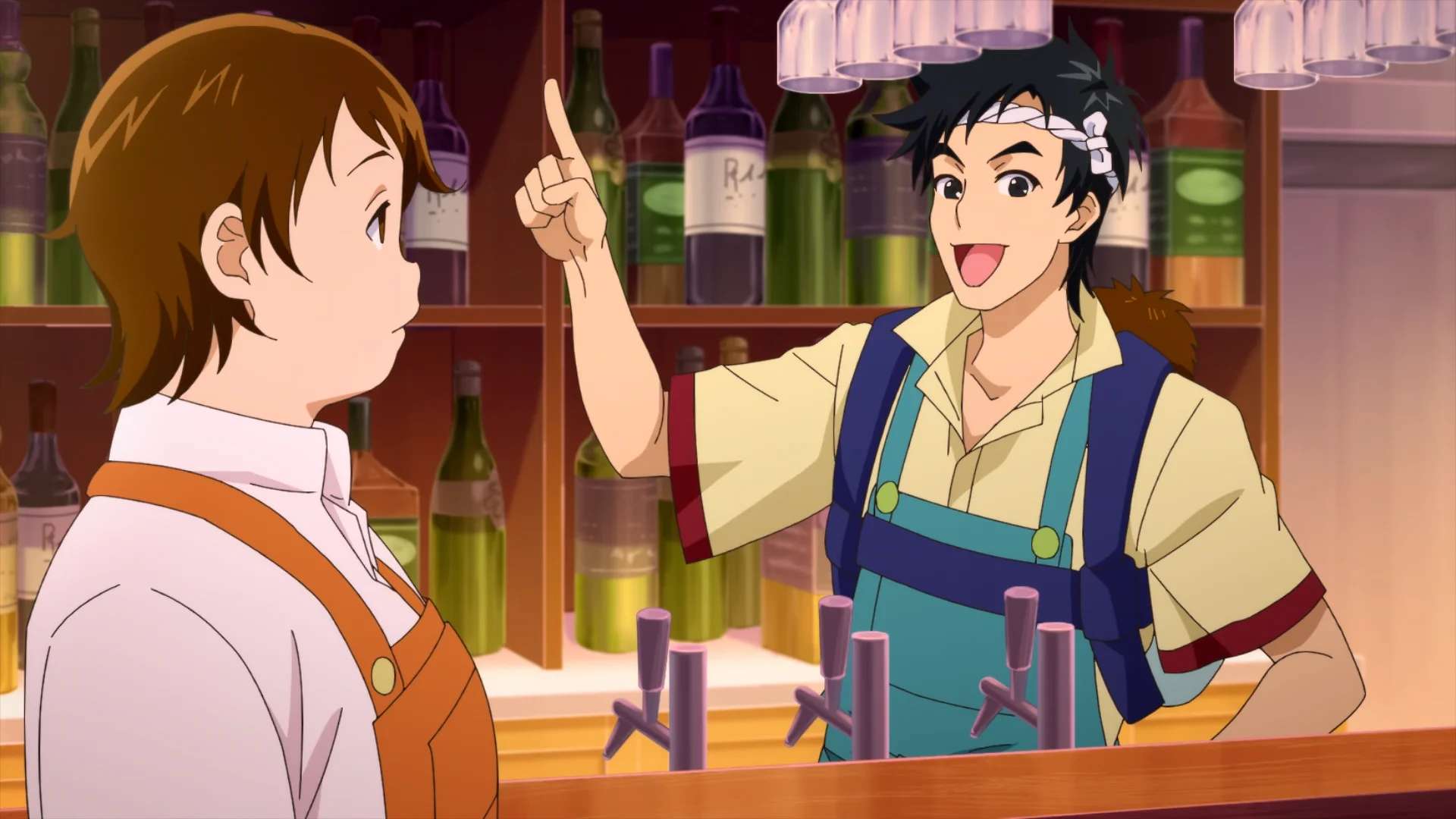
I wasn't expecting these two to be in the series at all.
Ultimately, the caveat expressed at the very start of Otona Precure (that there are many different possible futures, arguably making none of them capital-C Canon) ends up being the important factor. Maybe this is the possible future where Black, White, Luminous, Bloom, and Egret can all transform without their fairy mascot counterparts. Maybe this is the possible future where individual action can overcome industrialized irresponsibility. Maybe this is the possible future where the queen of Palmier Kingdom still works a day job in Japan. Oh. I'm going to have to address this, aren't I?
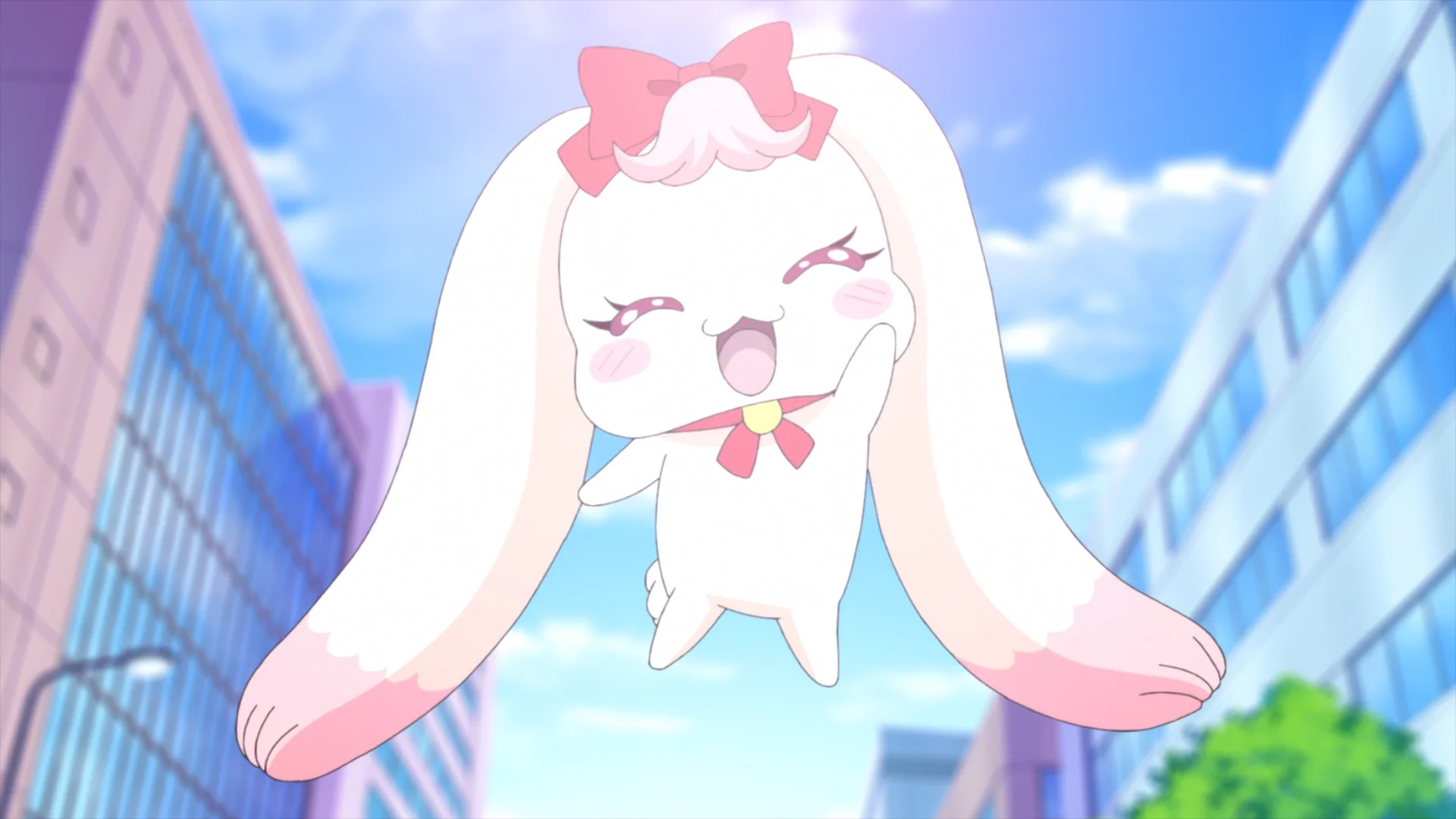
Otona Pretty Cure 2: Civil War.
I've never been a fan of the Nozomi x Coco 'ship, although I have to assume it's reasonably popular among the sort of audiences for whom Yes! Pretty Cure 5 was originally intended. In case you somehow still don't know, Coco is an adult who (we now learn) fell for Nozomi when he lured her into an alley met her by chance when she was 13. He was also her middle school teacher. Oh, and his human form is the alter ego of his real form, a ridiculous fairy mascot who is lucky to have Nuts by his side to make him look competent in comparison. And, yeah, he's the (a?) monarch of Palmier Kingdom, a country populated entirely by ridiculous fairy mascots doomed to fight an unavoidable water-rights war with the neighboring Donuts Kingdom. I expect losing this war will trigger the coup Milk has planned.
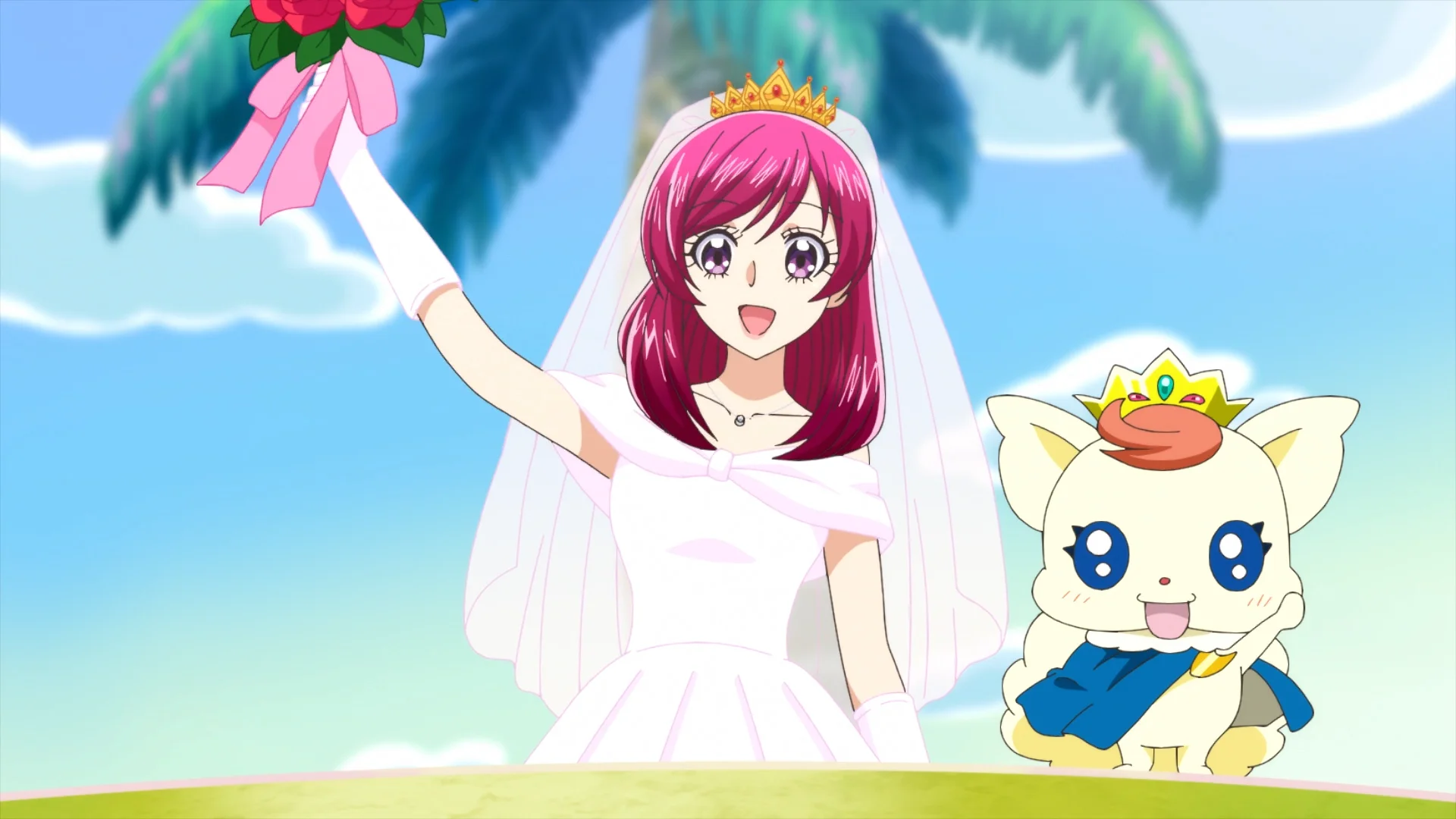
Was Coco in his fairy mascot form during the ceremony?
Did he include his verbal tic when reciting his vows?
ANYWAY, back in 2008, Coco and Nozomi (Cure Dream, technically) shared the first (and only?) on-screen kiss of the Pretty Cure franchise. Although Otona Precure did not feel beholden to pairing up Saki with Mai's brother, or Komachi with Nuts (Natts, whatever), or Urara with Syrup, it did not pass up the chance to goose the Nozomi x Coco 'shippers. So, now they're married (which really raises a lot of questions if you think about it even a little bit, but I recommend not dwelling on it at all), which explains why Coco was sort of hanging out for the second half of the show doing fuck all. He didn't need to be there, but I guess he did if he and Nozomi were going to get married. That didn't really need to happen during this season either, but I guess it did if "this season," is going to be "the only season," and there's no guarantee it's not. Maybe someday we'll get some more. Each tomorrow is but another possible future.
Posted in Futari wa Precure, Kibō no Chikara ~Otona Precure 23~, Pretty Cure (all), Splash Star, Yes! Precure 5 GoGo!, Yes! Pretty Cure 5 | Tags: Autumn 2023, Christmas Cake, Love Confessions, Mahou Shoujo, May-December Romances, Romance, Season Conclusion, Sequels, Spoilers, Twitter | Permanent Link
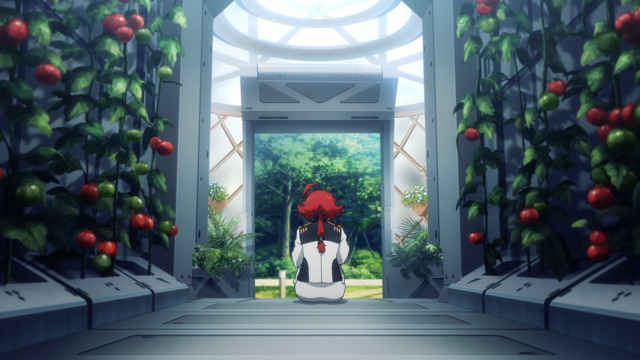
Maybe tomatoes count as a Miorine surrogate.
Continuing from my previous post about Kidou Senshi Gundam: Suisei no Majo Season 2 (Mobile Suit Gundam: The Witch from Mercury Season 2), I'm gonna go ahead and voice my primary beef with the way the show depicted Suletta's & Miorine's relationship. The short version is the series simply did not have enough episodes to adequately develop it. Or rather, it did, but it would have had to do so at the expense of something else. I suspect this is true of most of the areas that lacked sufficient elaboration for many viewers. (For example, anyone clamoring for more details about Miorine's mother, or about what tomatoes had to do with her Quiet Zero plans.)
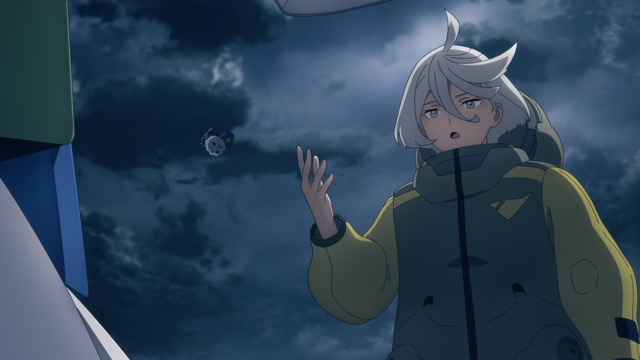
It's an act, but can you imagine Suletta doing something like this?
With regard to Suletta and Miorine specifically, nearly all of the slow, getting-closer parts that 'shippers might want occur almost entirely off-screen. Instead, we're treated to multiple instances of Miorine being distant, or cold, or outright cruel, and subsequent cathartic moments when she's realized she has fucked up and makes herself vulnerable to Suletta. All the less flashy (but still critical) incremental bond building occurs during time skips. It relies on the viewer to already be on board with the pairing, and willing to fill in the gaps with "head canon." Actually, not all of it was off-screen. A lot of it occurred during anachronistic dates across contemporary Japan shared on the Twitter.
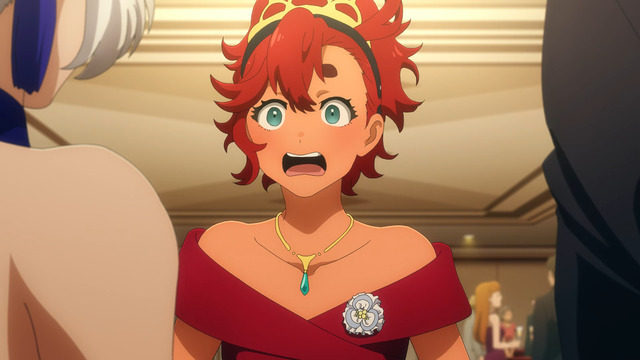
I guess this counts as a date.
I don't intend to belabor the point about these short vignettes that the @G_Witch_M account posted between cours, but I am serious about how these Suletta and Miorine Japan-tour snapshots are the clearest examples we have of the two actually going on dates or acting like a couple. This doesn't change the groundbreaking importance of their prime-time teenage lesbian marriage, but it is unfortunate that including regular romance material would have crowded out all the other Gundam-critical-type stuff that G Witch barely managed to include.
Posted in Gundam, Kidou Senshi Gundam: Suisei no Majo | Tags: 16-year-old love interests, Autumn 2022, Bad Things Happen to Good People, Bend Her Over a Kotatsu, Giant Robots, Gundam, Mecha, Romance, Season Conclusion, Sequels, Space, Space Opera, Spring 2023, Sunrise, Twitter | Permanent Link
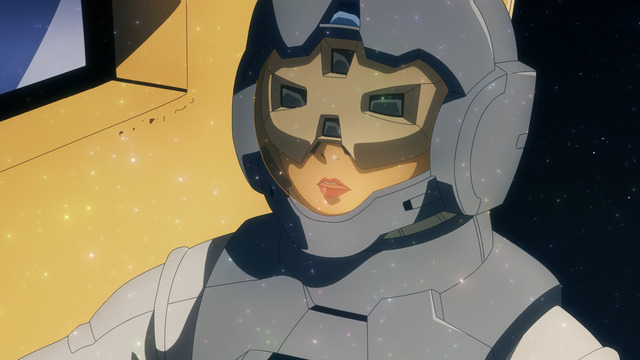
I heard you liked helmets.
Now that Kidou Senshi Gundam: Suisei no Majo Season 2 (Mobile Suit Gundam: The Witch from Mercury Season 2) has finished, I should probably capture my concluding thoughts on the series while they remain somewhat fresh. However, I get the feeling that would result in a long blog post, so maybe I ought to break things up into multiple entries despite the risk I might simply lose interest in writing more before completion. Anyway, the first post in this series (?) is about Elnora. If you've been following me on the Twitter, this should surprise you not at all.
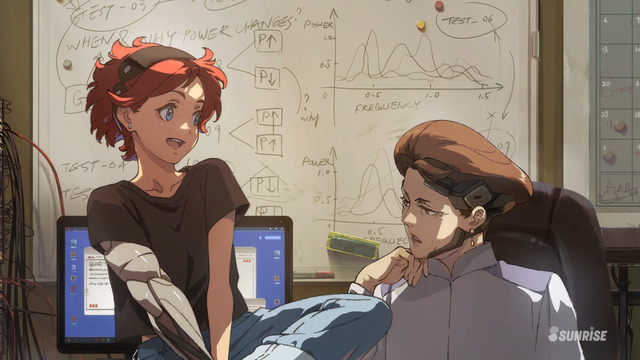
Notably, I never stopped seeing Elnora as the girl she used to be.
Many viewers (if not most viewers) seemed to regard Prospera as the main villain of the series. This is not an incorrect perspective, but I think it's incomplete. I take the position that she is both an antagonist and a protagonist. This is not to say that I thought of her as the protagonist—that's clearly Suletta—but I do see her as a protagonist. (Fuck your deuteragonist and tritagonist nonsense. You're reading an anime blog, not a fan wiki.) That's not a controversial position for me to take, is it?
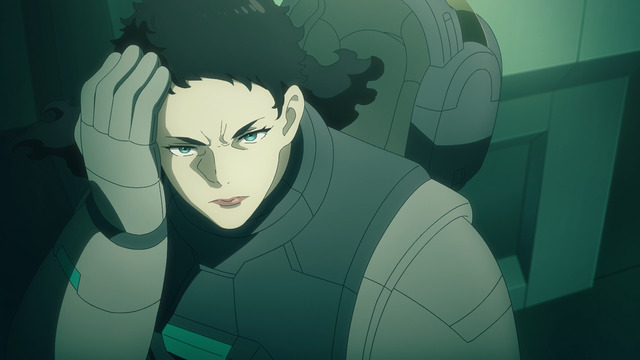
Maybe she'll start calling you Mom without sounding sarcastic.
I'll need to put more thought into this, but my initial impulse is to suggest Elnora embraced the forgiveness aspect reflected in (or constrained by) The Tempest a lot more readily than I expected. Like, she had already forgiven Delling during the scene where she's fucking with Miorine's head to get her to aspire for the Benerit leadership role, right?
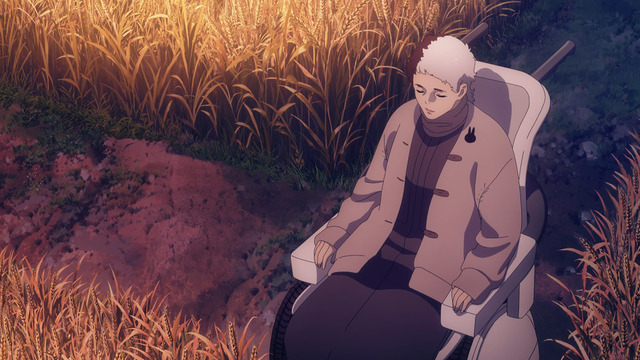
I wonder how soon Elnora realized she was going to end up in this chair.
I also found Prospera's Quiet Zero plot to be a lot less sinister than what most people were assuming. (Never mind that I still have no idea what Notrette's original Quiet Zero plan—or Delling's intentions for the project, for that matter—were meant to be.) Now, I'm not part of the "Prospera Did Nothing Wrong" faction, but I do view her actions from a position that is decidedly more favorable to her than most seem willing to adopt. Let's just say I'm grading on a curve.
Posted in Gundam, Kidou Senshi Gundam: Suisei no Majo | Tags: Autumn 2022, Bad Things Happen to Good People, Built for War, DARK MAMIKO, Giant Robots, Girls With Guns, Gundam, Incorruptible Loyalty, Mamikore, Mecha, Season Conclusion, Sequels, Shakespeare, Space, Space Opera, Spring 2023, Sunrise, Twitter, War Is All Hell | Permanent Link
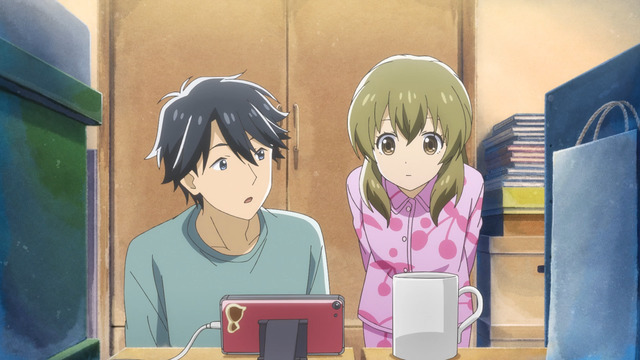
I can't tell if Itsuka is precocious or if Nagomu is just not very smart.
I get the feeling a lot of people on the Twitter avoided Deaimon: Recipe for Happiness because of overblown concerns the 10-year-old would grow up to marry the much older male lead. The manga is still ongoing, so I guess I can't rule out the possibility that this might happen, but I'm at least reasonably confident it hasn't happened (or else someone would have spoiled this by now). There are also other, much more likely love interests, namely Kanoko, Nagomu's girlfriend from the start of the series when he was still living in the city. Anyway, I'm going to go ahead and claim straight out that this is a dumb thing to worry about and people should just watch the show.
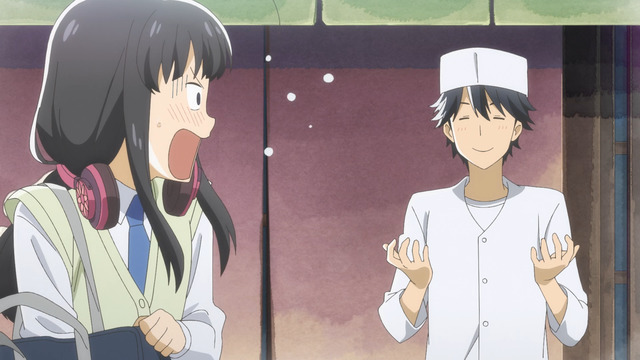
I'm not expecting him to fuck the high school girl either, okay.
Because, as it turns out, Deaimon is just sort of nice and well done all around. Through six episodes, it happens to be my highest-rated series of the Spring 2022 anime season (if you put any stock in my animetrics chart) despite not doing anything groundbreaking. Every episode has been consistently good, though, and I appreciate the yet-unresolved absurdity involving the girlfriend from the city. I'm more invested in that looming confrontation than the inevitable one involving poor Itsuka's shitty father. That's probably not the way I'm supposed to regard the main plot, but it is how it is.
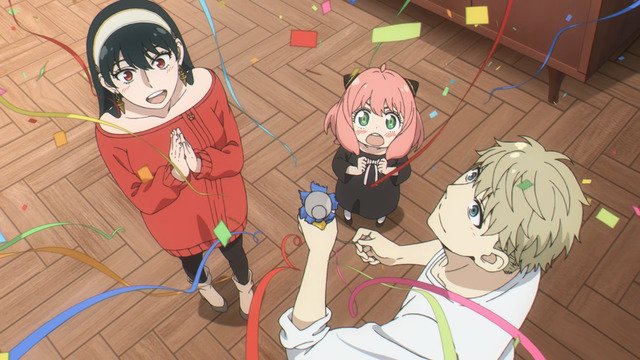
That's a nice floor.
As with Deaimon, SPY x FAMILY has also got that found-family thing going on, but y'all probably already know this because the series and the manga it's adapted from are both popular. Basically, if you're not watching SPY x FAMILY already, you probably should be. I won't claim it's an exceptional anime, but it does do all the things you'd want it to do, and it does them really well. I've read enough of the manga to feel confident both of the planned split cours of the anime will remain entertaining, even though I'm not looking forward to Yor's brother showing up.
Posted in Deaimon, SPY x FAMILY | Tags: Bad Things Happen to Good People, Compare and Contrast, Initial impressions, Manga, Season Introduction, Spring 2022, Twitter | Permanent Link
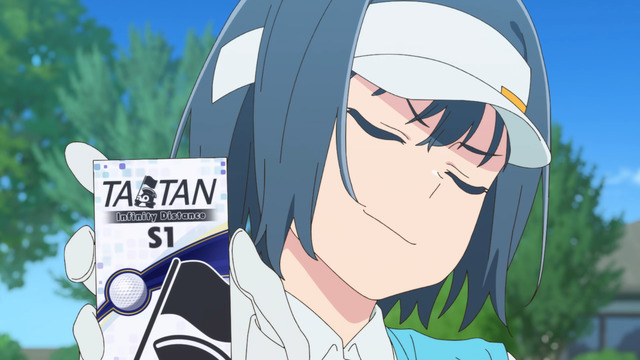
This is product placement, isn't it?
Sorairo Utility (Sky Blue Utility) is only a single 15-minute OVA? That's it? You're kidding me! Well, that leaves me with one less show than I was expecting to follow during the Winter 2022 anime season. That's unfortunate, because it was nicely done. There is no shortage of shows about girls who obsess over a particular hobby, but this felt much more natural and realistic than the typical fare.
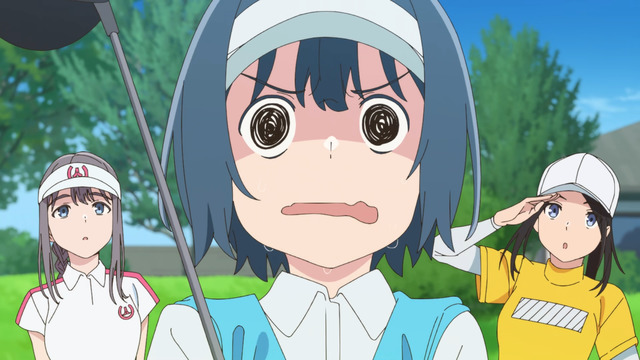
It happens.
I learned of Sorairo Utility from one of the hundreds of artists I sort of follow on the Twitter. Specifically, the director, Saitou Kengo occasionally mused about wanting to make a girls-playing-golf anime, and then suddenly it became a reality. I have no idea if there is ever going to be any more, but I'd certainly be in favor of it.
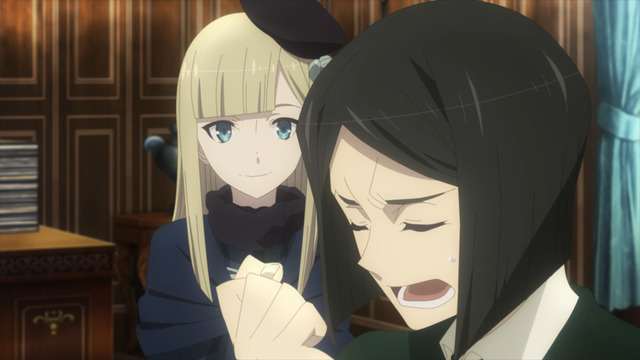
I did appreciate Reines sassing Waver.
Sort of unrelated aside from also coming out on 31 December 2021 is Lord El-Melloi II Sei no Jikenbo: Rail Zeppelin Grace Note - Tokubetsu-hen (Lord El-Melloi II's Case Files: Rail Zeppelin Grace note TV Anime's Special Edition), a short movie about magic shenanigans involving Waver's classmates from his pre-Fate/Zero days. I feel like I would have liked this more if I had a greater grasp on TYPE-MOON lore in general, but possibly not understanding is the normal and expected state.
Posted in Lord El-Melloi II Sei no Jikenbo {Rail Zeppelin} Grace note, Sorairo Utility | Tags: Autumn 2021, First Episode, golf, Initial impressions, Labor of Love, Movies and OVAs, Product Placement, Season Conclusion, Season Introduction, Short Shows, Twitter, TYPE-MOON, Ueda Reina, Winter 2022 | Permanent Link

I know it's her (other) gimmick, but these are some fucked-up bangs.
Getsuyōbi no Tawawa 2 (Tawawa on Monday 2) is a follow-up to an Autumn 2016 adaption of Himura Kiseki's weekly illustrations that publish on the Twitter every Monday. There's continuity and regular characters whose lives intersect with otherwise unrelated story arcs. But really it's just an exercise in randy situation comedies involving enormous breasts. The anime episodes are short and faithfully follow the various stories, but it still looks weird to me without the blue-ink monochrome of the source material.
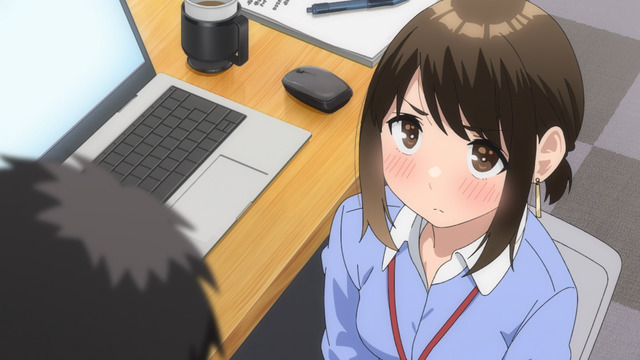
Never gonna happen.
Ganbare Dōki-chan (You Can Do It Dōki-chan) is another anime short and was paired with the Tawawa sequel for its debut because the Douki-chan artist and the Getsuyōbi no Tawawa artist collaborate on occasion. Unlike the Tawawa illustrations, Douki-chan follows a single story arc. Its titular heroine is a lovesick office lady who lacks the confidence to express her feelings to the co-worker she admires. Complicating the effort are myriad assertive rivals who always seem to appear at inopportune moments. Both Getsuyōbi no Tawawa 2 and Ganbare Dōki-chan have already concluded their 12-episode runs because they started toward the end of the Summer 2021 anime season. As anime adaptations go, they were all right, but it's good their episodes were short. I don't think either would have worked with full-length episodes.
Posted in Ganbare Dōki-chan, Tawawa on Monday | Tags: 16-year-old love interests, Autumn 2021, Bend Her Over a Kotatsu, Built for Sin, Childhood Friend, Fan Service, Hair, Initial impressions, Kayano Ai, Love Confessions, Love Triangle, May-December Romances, Plying Girls, Romance, Season Introduction, Sequels, Sex, Summer 2021, Turbo Lesbians, Twitter, Unrequited Love | Permanent Link
|
|






